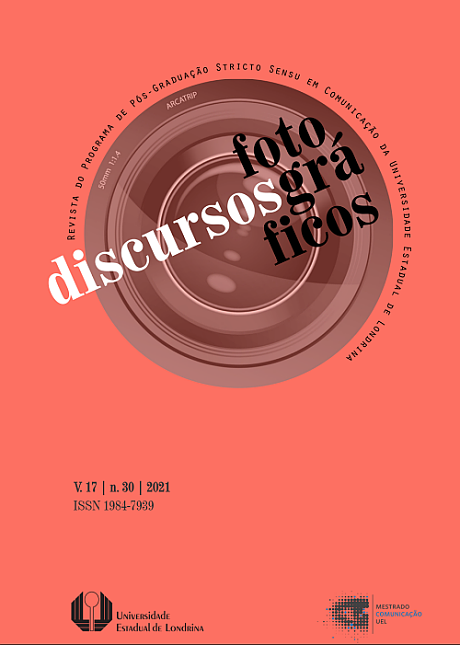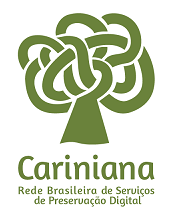Memory and photography in Yolocaust
DOI:
https://doi.org/10.5433/1984-7939.2021v17n30p111Keywords:
Photography, Memory, Art. HolocaustAbstract
Yolocaust is a project by Israeli artist Shahak Shapira that reorganizes photographs taken by visitors to the Holocaust Memorial in Berlin posted on various social networks superimposing them with images of Nazi death camps. In the present work, we analyze some images, with close attention to how temporal and documentary aspects make the images act on memories on the death camps.Downloads
References
ASSMAN, Aleida. Espaço da recordação: formas e transformações da memória cultural. Campinas: Unicamp, 2011.
BADISERRA, Raquel; TEIXEIRA, Maria Claudia. Memorial do holocausto: memória e sentidos. Revista Gatilho, Juiz de Fora, v. 19, n. 2, 2020.
BALDWIN, Eric. Peter Eisenman: designing Berlin’s holocaust memorial. 29 abr. 2020. Disponível em: https://www.archdaily.com/938511/peter-eisenman-designing-berlins-holocaust-memorial. Acesso em: 18 ago. 2021.
BAREITHER, Christoph. Difficult heritage and digital media: ‘selfie culture’ and emotional practices at the Memorial to the Murdered Jews of Europe. International Journal of Heritage Studies, Canberra, v. 27, n. 1, p. 57-72, 2021.
BENJAMIN, Walter. Passagens. Belo Horizonte: Editora da UFMG, 2007.
CARMO, Eduardo; ROSA, Lígia; LEMOS, Anuschka. Yolocaust: usos e manipulações da fotografia e memória. In: CONGRESSO BRASILEIRO DE CIÊNCIAS DA COMUNICAÇÃO, 40., 2017, Curitiba. Anais [...]. Curitiba: Intercom, 2017.
CIQUINI, Fábio. A estrutura narcísica no imaginário midiático e nas selfies. Revista Logos, Rio de Janeiro, v. 27, n. 1, 2020.
COHEN, Alina. Martha Rosler’s powerful collages are a wake-up call to America. Artsy, New York, 28 jan. 2018. Disponível em: https://www.artsy.net/article/artsy-editorial-martha-roslers-powerful-collages-wake-up-call-america. Acesso em: 3 jun. 2020.
COSTA, Thiago; BASTOS, Maria Teresa Ferreira. Selfies em memoriais: uma análise do luto na era dos smartphones. Revista Mídia e Cotidiano, Rio de Janeiro, v. 13, n. 1, 2019.
DANEY, Serge. Le Travelling de Kapo, Trafic, Paris, n. 4, 1992.
DE DUVE, Thierry. A arte diante do mal radical. Ars, São Paulo, v. 7, n. 13, 2009. Disponível em http://www.revistas.usp.br/ars/article/view/3062. Acesso em: 18 ago. 2021.
DIDI-HUBERMAN, Georges. Imágenes pese a todo: memoria visual del holocausto. Barcelona: Espasa, 2012.
FONTCUBERTA, Joan. La furia de las imágenes: notas sobre la Postfotografía. Barcelona: Galaxia Gutenberg, 2016.
FRIEDLANDER, Saul. Proibing the limits of representation: nazism and the “final solution”. Londres: Harvard University Press, 1992.
GAGNEBIN, Jeanne Marie. Lembrar, escrever, esquecer. São Paulo: Editora 34, 2009.
GAGNEBIN, Jeanne Marie. Limiar, aura e rememoração: ensaios sobre Walter Benjamin. São Paulo: Editora 34, 2014.
GUNTER, Joel. Yolocaust: how should you behave at a holocaust memorial? BBC News, [S. l.], 20 jan. 2017. Disponível em: https://www.bbc.com/news/world-europe-38675835. Acesso em: 18 ago. 2021.
HARTMAN, Geoffrey. Holocausto, testemunho, arte e trauma. In: SELIGMAN-SILVA, Márcio. Catástrofe e representação. São Paulo: Escuta, 2000.
HARTOG, François. Regimes de historicidade: presentismo e experiências do tempo. Belo Horizonte: Autêntica, 2019.
HILBERG, Raul. La destrucción de los judíos europeos. Madrid: Akal, 2005.
HOWE, Irving. Art of holocaust. Londres: Pan Macmillan, 1982.
HUYSSEN, Andreas. Culturas do passado-presente: modernismos, artes visuais, políticas da memória. Rio de Janeiro: Contraponto, 2014.
KEHL, Maria Rita. O sexo, a morte, a mãe e o mal. In: SELIGMAN-SILVA, Márcio. Catástrofe e representação. São Paulo: Escuta, 2000. p. 137-148.
KUSPIT, Donald. El fin del arte. Madrid: Akal, 2012.
LAZAROVIC, Samira. Eu queria que as pessoas falassem sobre a cultura das selfies. Goethe Institut, Curitiba, maio 2018. Disponível em: https://www.goethe.de/ins/br/pt/kul/fok/mid/20946058.html. Acesso em: 18 ago. 2021.
LEVI, Primo. A assimetria e a vida. São Paulo: Unesp, 2014.
RANCIÈRE, Jacques. A partilha do sensível: estética e política. São Paulo: Editora 34, 2005.
ROTHBERG, Michael. Sobre o caso Mbembe: o fantasma da comparação. Tradução de Cláudio Andrade. Goethe Institut, Curitiba, maio 2020. Disponível em: https://www.goethe.de/ins/br/pt/kul/mag/21864662.html. Acesso em: 3 jun. 2020.
ROTHBERG, Michael. Traumatic realism: the demands of holocaust representation. Mineápolis: University of Minnesota Press, 2000.
SELIGMAN-SILVA, Márcio. Catástrofe e representação. São Paulo: Escuta, 2000.
SELIGMAN-SILVA, Márcio. História, memória, literatura: o testemunho na era das catástrofes. São Paulo: Unicamp, 2003.
SELIGMAN-SILVA, Márcio. O local da diferença: ensaios sobre memória, arte, literatura e tradução. São Paulo: Editora 34, 2005.
SONTAG, Susan. Regarding the torture of others. The New York Times Magazine, New York, 23 may 2004a. Disponível em: https://www.nytimes.com/2004/05/23/magazine/regarding-the-torture-of-others.html. Acesso em: 3 abr. 2020.
SONTAG, Susan. Sobre fotografia. São Paulo: Companhia das Letras, 2004b.
ZELIZER, Barbie. Remembering to forget: holocaust memory through the camera’s eye. Chicago: University of Chicago Press, 1998.
Downloads
Published
How to Cite
Issue
Section
License
Copyright (c) 2021 Discursos Fotográficos

This work is licensed under a Creative Commons Attribution-NonCommercial 4.0 International License.
Discursos fotográficos adota a licença CC-BY-NC, esta licença permite copiar e redistribuir o material em qualquer meio ou formato, remixar, transformar e desenvolver o material, desde que não seja para fins comerciais. E deve-se atribuir o devido crédito ao criador.

Este obra está licenciado com uma Licença Creative Commons Atribuição-NãoComercial 4.0 Internacional.













